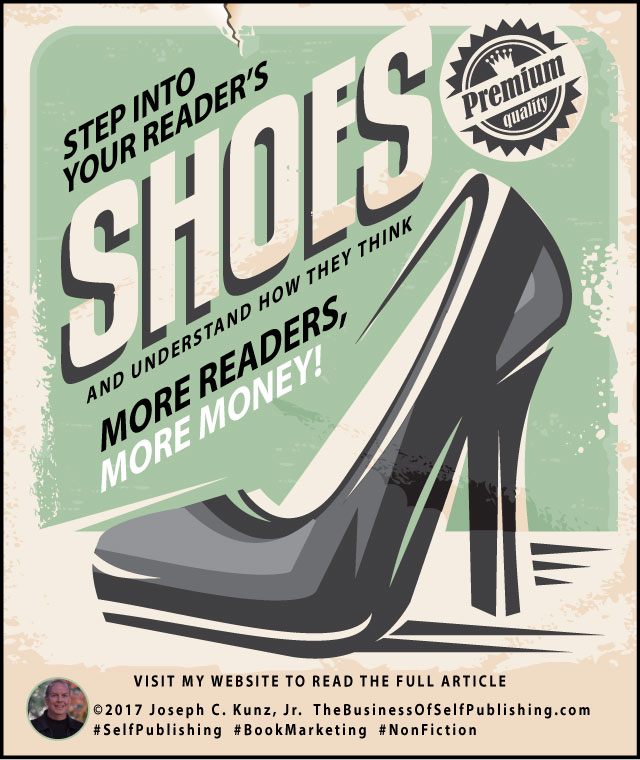Podcast: Play in new window | Download
Subscribe: Apple Podcasts | Spotify | Pandora | RSS | More
Updated September 13, 2023
Subtitle
Understanding the buyer’s first impression of your book can boost your book sales significantly
Synopsis
If you hope to have your book achieve financial and critical success, you must understand the book shopper’s perception of your book when they first see it. Once you understand their thought process, you can adjust your book accordingly and significantly improve your chances of making a sale.

What You Will Learn
1. You will learn how to improve your book’s sales by fully understanding how your readers perceive you and your book.
2. You will learn what specific questions you must ask yourself to improve the reader’s perception of you and your book.
3. You will learn what readers first notice about your book and how those things can affect their perceptions.
Introduction
If you have any hope of having your book achieve financial and critical success, you must understand how book buyers (your customers) view your book (your product) when they first see it (online or on a shelf). Once you understand their thought process, you can adjust your book accordingly and significantly improve your chances of making a sale.

Put Yourself in the Shoes of the Buyer
To understand how book buyers perceive your book, you must separate yourself from your feelings about your book and think as the objective and the skeptical buyer would think. Think about who your audience is, try to step into their shoes, and then look at your book objectively and subjectively – through their eyes.
Important Questions to Ask Yourself
1. What would attract you to a book like yours?
2. What would attract people in your audience to a book like yours?
3. Would you be more attracted to a beautiful cover or the cover blurbs as a buyer?
4. Would you buy a book based on its cover art or because of the well-known names quoted?
5. Does the book’s page count seem too long or too short to cover the topic adequately?
6. Does the subtitle seem to be promising too much for such a topic?
7. How do your book’s attributes compare to those within your subject category?
8. Does the information, images, graphics, fonts, etc., on the front and back cover seem appropriate and respectful for the topic?
9. Does the table of contents appear to cover all the essential topics necessary for this book’s subject?
Here Is a Quick Look at a Few of the Subjective and Objective Items Book Buyers Notice When They First View Your Book:
1. Cover Art
Having the appropriate graphics, images, photos, illustrations, colors, fonts, etc., is essential if you expect to get noticed by book buyers. Books with great-looking covers almost always sell better than tedious, confusing, or unprofessional-looking ones.
What needs to be on your book’s cover that will draw in or attract a reader and a buyer? Are the graphics, colors, and fonts appropriate to the book’s subject matter? Make sure that you design several covers. And don’t be afraid to hire professional help.

2. Title and Subtitle
Your title must grab buyers as quickly as possible. Generally, it must let the reader know what your book is about in as few words as possible. You can give more specific details in the subtitle. The subtitle is where the author lets the buyer know what the book is about. When deciding which book to purchase, the buyer usually gives more weight to the subtitle than the main title.
3. Author’s Name
The well-known big names will always get more attention. But there are several ways for less famous authors to get the shopper’s attention. The new or less renowned author can impress the consumer by putting the title of a previous book they wrote directly under their name on the cover.
One of the best ways to bring attention to a lesser-known author is to get a much more prominent or well-known name to write the book’s foreword. This person’s name will also appear on the cover, directly below the author’s. They could also bring attention to their business or personal website, which the consumer can quickly browse.
4. Cover Blurbs
Blurbs, or short testimonials, are essential for making book sales. You must get them from various sources, not just the big names. The best are from big-name authors and celebrities and should be on your front and back cover. You should include the other blurbs you receive inside your book and on your website.
5. The Foreword
The foreword is a discussion about why the reader should read your book. It is where a guest author shows the reader why they should be reading this book. If written correctly and by the appropriate person for the job, the book’s author will gain a lot of credibility in the book buyer’s eyes.
6. The Preface
The preface is a discussion about how the book came about. It is a place for the book’s author to tell the reader how this book came into being and why. This will build credibility for the author and the book. More credibility will translate into more book sales.
7. The Introduction
The introduction is a discussion about the content of the book. Here, the author sets the stage for the reader and prepares them for what can be expected from reading the book. The introduction grabs the reader and intensifies the reader’s desire to find out more, hopefully devouring the entire book.

Conclusion
The key to successfully getting book buyers to notice you and your book is to force yourself to look at the book as if you are a buyer, not the author. Be objective and brutal with yourself and your book.
Ask your family and friends for their honest advice. We all know someone who does not hold back. Find this person and ask for their help. Compare your book to others, especially those from successful authors and those from big publishing companies.
Spend an hour or two in a big bookstore, walking around and examining the books all over the store, not just in your book’s section. What catches your eye? How does yours compare? What is your first impression of the other books?
This process is not complex, but you must devote some serious time to it. Remember, you are asking someone to spend their money, trust, and time on you and your book. Someone who has been misled many times buying books that overpromise and underdeliver.
Put yourself in their shoes and see the world as they see it, and you will create a fantastic book that sells for many years to come.
Questions to Think About
1. After getting feedback from your audience, which of your perceptions about your audience changed?
2. How did this affect the way you looked at your book? Did you then make any changes based on this new info?

